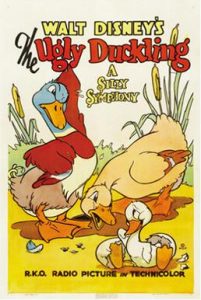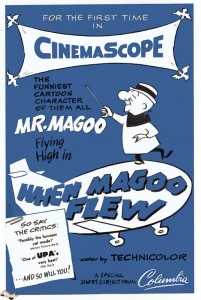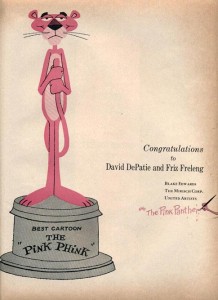 When Johnny Carson hosted the Academy Awards, he once called it: “Two hours of sparkling entertainment spread out over a four-hour show.”
When Johnny Carson hosted the Academy Awards, he once called it: “Two hours of sparkling entertainment spread out over a four-hour show.”
Yes, the show can go on a bit long. Still, thankfully for animation fans, one of the awards sandwiched there, in the midst of the opening monologue and the Best Song musical numbers, is the Academy Award for Best Animated Short Film.
Through the years, a number of now classic animated shorts from the golden age of cartoons have taken home the gold in this category. To commemorate this year’s Oscars airing this coming Sunday on ABC, here is a look back at just four of these classic animated shorts, each an Oscar winner for Best Animated Short Film that year and each one also celebrating an anniversary this year.
The Ugly Duckling (1939) – Disney – 85th Anniversary
This Disney Silly Symphony is a heartfelt and heartbreaking little film that, like the best of the studio’s short films, packs tremendous emotion into its brief run time.
 Directed by Jack Cutting and Clyde Geronimi, it tells the Hans Christian Andersen Tale (which Disney had adapted once before in 1931). The Ugly Duckling opens with a mother and father duck eagerly awaiting their eggs to hatch.
Directed by Jack Cutting and Clyde Geronimi, it tells the Hans Christian Andersen Tale (which Disney had adapted once before in 1931). The Ugly Duckling opens with a mother and father duck eagerly awaiting their eggs to hatch.
When one does, out pops a cute, little white ducking who looks different than their siblings (they even make a “honk” sound, while the others quack), and is ultimately shunned by the family and sets off on their own.
Trying desperately to find another family, the dejected Ugly Duckling is alone, until a mother swan and her cygnets embrace and adopt them, as the Ugly Duckling was indeed a beautiful swan.
As the short ends, the little swan sees the former duck family but sticks their nose in the air and swims off.
Except for “honks and quacks,” The Ugly Duckling is told without the benefits of dialogue and with some wonderful character animation eliciting great personality that connects with the audience (among the many talents who worked on the film were legends such as Milt Kahl and Eric Larson).
From their humorous first appearance on screen, where they appear wearing half an eggshell, to a sequence where they desperately try to befriend a decoy duck, it’s easy to feel for the brokenhearted Ugly Duckling.
The short is also filled with beautiful sequences (the backgrounds are credited to Samuel Armstrong and Phil Dike), including an evocative one where the dejected Duckling walks through the woods as shafts of light shine through the trees.
It’s no wonder that The Ugly Duckling took home that year’s Oscar and became considered a classic Disney short subject. Like the title character discovering they’re a swan, these are fitting victories for The Ugly Duckling.
Mouse Trouble (1944) – MGM – 80th Anniversary
This outing deserved its Oscar as it was the epitome of a Tom and Jerry cartoon and crafted with sharp humor.
 Tom eagerly awaits a book in the mail, “How to Catch a Mouse” (“A Random Mouse Book”). As Tom reads each chapter throughout the cartoon, we get vignettes as he tries out the book’s advice to capture Jerry.
Tom eagerly awaits a book in the mail, “How to Catch a Mouse” (“A Random Mouse Book”). As Tom reads each chapter throughout the cartoon, we get vignettes as he tries out the book’s advice to capture Jerry.
Tom attempts a mouse trap, but it is his finger that gets caught in it; he attempts to trap Jerry with a snare, but Jerry replaces the cheese with a dish of milk, and Tom gets caught; he chases Jerry into a corner when the book assures him that a cornered mouse never fights, after which Jerry pummels him (followed by Tom, breaking the fourth wall, looking at the camera and declaring “Don’t you believe it!” the catchphrase of a popular radio program at the time, of the same name).
In another mishap, Tom also loses his hair and hysterically wears an orange toupee for the remainder of the film while trying to trap Jerry with a wind-up female mouse that continually repeats the famous Mae West line, “Come up and see me sometime.” Tom inadvertently swallows the wind-up toy and repeats the Mae West line every time he hiccups.
Finally fed up with all his efforts, Tom acquires explosives (A LOT) and places them around Jerry’s mouse hole. When the explosion happens, however, it’s Tom who takes the brunt of it, turning into an angel floating into the clouds, constantly hiccupping, “Come up and see me sometime.”
With the legendary William Hanna and Joseph Barbera directing and fellow legends such as Kenneth Muse and Irv Spence animating, Mouse Trouble is solid gold Tom and Jerry, so it’s no surprise it brought home the gold on Oscar night.
 When Magoo Flew (1954) – UPA – 70th Anniversary
When Magoo Flew (1954) – UPA – 70th Anniversary
Just as Mouse Trouble was a quintessential Tom & Jerry cartoon, When Magoo Flew is a quintessential Mr. Magoo outing.
As the cartoon opens, Mr. Magoo (voiced by Jim Backus) is leaving his house to go to the movie theater. In a bit of a self-deprecating jab, the theater that Magoo passes plays “The Tattle Tale Heart “(just one year after UPA released an animated adaptation of Edgar Allen Poe’s The Tell-Tale Heart).
Magoo’s nearsightedness has him thinking that the airport across the street is the theater, and he boards an airplane, thinking it’s a movie theater. He even believes that the film’s name is “Fasten Seat Belts,” and the film’s 3-D is shockingly realistic.
Magoo watches an interaction between the stewardess and a police officer who is looking for a man with a briefcase who is wanted (and happens to be seated next to Magoo). Magoo, of course, thinks that this is the film.
He winds up opening the door and wandering out on the wing when he gets hold of the briefcase. He wants to return it to lost and found. He then winds up inadvertently turning it in to the police officer and solving the case.
Directed by Pete Burness and written by Barbara Avedon and Tedd Pierce, When Magoo Flew is a marvel of non-stop nearsightedness gags, coupled with well-executed animated choreography. As Magoo sits in the plane, thinking he’s at the movies, he marvels at the effects, exclaiming, “You can feel the plane moving!” Later, while walking precariously on the wing, he looks out at the sky and says, “Oh, that widescreen!”
As Magoo disembarks the plane, thinking he is leaving the movie theater, he thanks the stewardess, saying that he enjoyed the movie, but notes that he wishes there had been a cartoon and asks if they ever show many starring that near-sighted man.
Yes, those Mr. Magoo shorts were always welcomed by audiences, and this one most definitely deserved a welcome from Oscar.
The Pink Phink (1964) – UA – 60th Anniversary
“Remember me? First, I was a movie title…now I’m a movie star!!!”
This is what the poster for The Pink Phink declared, as it was the first cartoon short to star the Pink Panther since he starred in the animated opening credits of the live-action movie of the same name.
 Phink is an apt title for this debut short, as that is precisely what the Pink Panther is, spending the entire short torturing a painter who is trying desperately to paint a house blue. At the same time, the Panther follows along, painting it pink.
Phink is an apt title for this debut short, as that is precisely what the Pink Panther is, spending the entire short torturing a painter who is trying desperately to paint a house blue. At the same time, the Panther follows along, painting it pink.
The Pink Panther does everything to the put-upon painter, from painting pink stripes to putting pink paint in a sprinkler and turning it on to spray an entire room. When the painter grabs a shotgun, the Pink Panther fills it with pink paint, and when it’s fired, it turns a blue house pink, one shot at a time.
As it is the character’s style, there’s no dialogue in the short, just Henry Mancini’s iconic Pink Panther theme from beginning to end, like wonderful, musical wall-to-wall carpeting.
The Pink Phink was directed by Friz Freleng, with co-director Hawley Pratt, two legends from Warner Bros., who most definitely knew how to stage perfectly timed sight gags. Here, it’s coupled with a sparse stylized look (at times, it’s just the characters against a white background) that uses color and design brilliantly. Even the painter (known in the Pink Panther cartoons as “the Little Man”) is a simple, egg-like shape with arms, legs, eyes, nose, and mustache.
The character of the Pink Panther would evolve through the years, but it’s interesting to look back on his first appearance, where he excels at troublemaking. The filmmakers creatively generated genuine laughs, which rightfully caught the attention of the Academy, bringing Oscar gold to The Pink Phink
These are just four of the many Oscar-winning animated short subjects through the years since the award was first presented in 1932. Each was celebrated by the Academy, is celebrating an anniversary this year and set a gold standard.


 Michael Lyons is a freelance writer, specializing in film, television, and pop culture. He is the author of the book, Drawn to Greatness: Disney’s Animation Renaissance, which chronicles the amazing growth at the Disney animation studio in the 1990s. In addition to Animation Scoop and Cartoon Research, he has contributed to Remind Magazine, Cinefantastique, Animation World Network and Disney Magazine. He also writes a blog, Screen Saver: A Retro Review of TV Shows and Movies of Yesteryear and his interviews with a number of animation legends have been featured in several volumes of the books, Walt’s People. You can visit Michael’s web site Words From Lyons at:
Michael Lyons is a freelance writer, specializing in film, television, and pop culture. He is the author of the book, Drawn to Greatness: Disney’s Animation Renaissance, which chronicles the amazing growth at the Disney animation studio in the 1990s. In addition to Animation Scoop and Cartoon Research, he has contributed to Remind Magazine, Cinefantastique, Animation World Network and Disney Magazine. He also writes a blog, Screen Saver: A Retro Review of TV Shows and Movies of Yesteryear and his interviews with a number of animation legends have been featured in several volumes of the books, Walt’s People. You can visit Michael’s web site Words From Lyons at: 






















There is a semblance of dialogue in “The Ugly Duckling”, where the mother and father ducks are arguing following the birth of the ugly one. I assume this was rendered by Jimmy MacDonald blowing on a couple of duck calls, but the cadence and intonation mimic human speech so perfectly that it’s possible to discern actual words. “So, how did this happen?” “I don’t know!” “Well, he doesn’t take after me!” Papa duck even utters an “Ah, phooey!” as clearly as Clarence Nash ever did for Donald — a virtuoso performance, whoever was responsible for it. This is an example of genuine “duckspeak” years before Orwell coined the term.
But as far as I’m concerned, the best cartoon of any given year is only rarely the one that won the Oscar.
I also feel like the cartoons that really deserved it, never won or was nominated for best animated short subject.
Yet, I feel like all of these cartoons highlighted in this article deserve to be included in The Library of Congress’ National Film Registry. I even regain confidence on continuing to nominate “Mouse Trouble” in my future annual lists to them thanks to this article (I was considering of replacing it with “The Cat’s Concerto” (1947) since it’s more well-known).
While the “Ugly Duckling” was presented without words (although my friend Paul cogently points out that the film is not entirely devoid of dialogue) the comic strip and comic book versions both include dialogue which fleshes out the characters and explains where the egg came from. Plus, the dialogue helps us to get to “know” the Ugly Duckling a little more, although the cartoon works best without this dialogue or exposition. Note that in Disney’s version the Duckling does not grow up at the end–instead the mother swan is there to give us an idea of what he will look like when he grows up. But he knows what species he is and is thus able to enjoy a happy ending with his newfound brothers and sisters.
In “Mouse Trouble,” one of the best things about it is that the gags build as the cartoon progresses, instead of the slate being wiped clean at the close of every gag with no reference to what has come before, as is the formula for many cartoons of this nature of predator vs. prey. Thus, the climactic finish is exactly that–an inevitable finale to the episode, which has built up piece by piece from the beginning. It’s very fortunate for Tom that cats have nine lives!
“When Magoo Flew” has one mistake in it, when Magoo reads aloud from a sign and says the words exactly as written. It would have been more consistent with the other cartoons for him, as usual, to interpret the sign with his own idea of what it says. That is my only quibble with this otherwise excellent and representative Magoo outing.
As for the Pink Panther, here is another character who gained speech and dialogue when he made the jump to the printed page. The first Gold Key issue of “The Pink Panther” includes several plots derived from the cartoons, but in which the Panther speaks. While he occasionally uttered words in the cartoons, this never seemed “the norm” for the character. My mother made the comment that the Pink Panther “Is like a silent movie.” This was after an evening at church when we had been treated to a special showing of Chaplin’s film “The Gold Rush” and we were quite entranced with silent films at the time. Indeed, the Panther is for the most part very Chaplin-esque.
Really?
Nothing on/about International Womens Day?
It’s still incomprehensible to me how “Speedy Gonzales” (69th Anniversary) won and “One Froggy Evening” wasn’t even nominated. The winning Warner Bros. cartoons all seem to be odd choices when so many better ones went unnoticed or the competition was too strong; the mediocre “Knighty Knight Bugs” (66th Anniversary) got lucky because MGM had shut down its cartoon studio and UPA was on its last legs, and even then I’d rather have had “Baton Bunny” win that year.
A lot of people think “Popeye Meets Sindbad” (88th Anniversary) got robbed, but I can handle that not winning; I’m just glad it was nominated.
Hi Hans, always like reading your comments and contributions to this community.
In fairness to the Academy re: “Speedy Gonzales” vs. “One Froggy Evening”, Warners did not submit the latter film for consideration, so there is no way it could have been nominated. The blame lies with Selzer and co. on that one! Admittedly, Speedy must have seemed like a breath of fresh air at the time, and is a very entertaining cartoon in its own right, if nothing TOO remarkable.
To be honest, I’m still a bit disappointed that the former didn’t make in “The 100 Greatest Looney Tunes” book.
Perhaps the Academy voters saw a cat and mouse and thought that Speedy Gonzalez was a Tom and Jerry cartoon, so they voted for it, seeing how the Academy seemed to love MGM’s cat and mouse so much. (Probably not, though…but it was too amusing a thought not to write down).
Tom’s orange toupee is one of the funniest things I’ve ever seen.
It never fails to reduce me to hysterical laughter every time I see it.
Michael, thank you for giving some love to “The Pink Phink” 🐾. Friz Freleng and Hawley Pratt were indeed legends and this wonderful cartoon was very worthy of an Oscar.